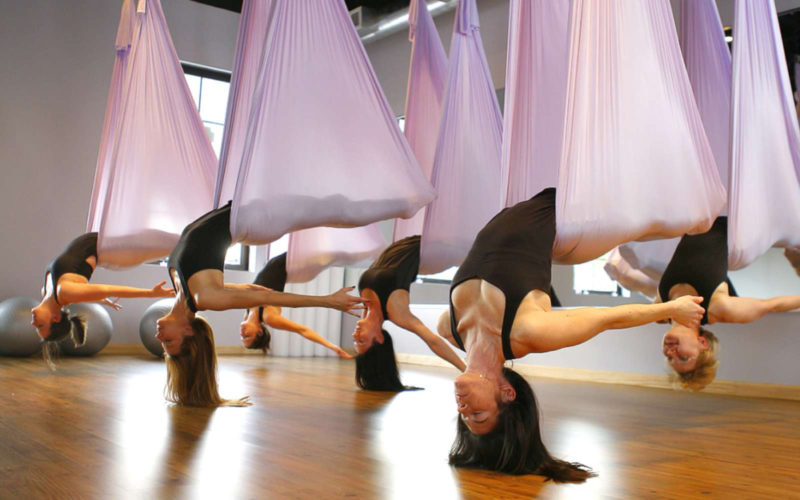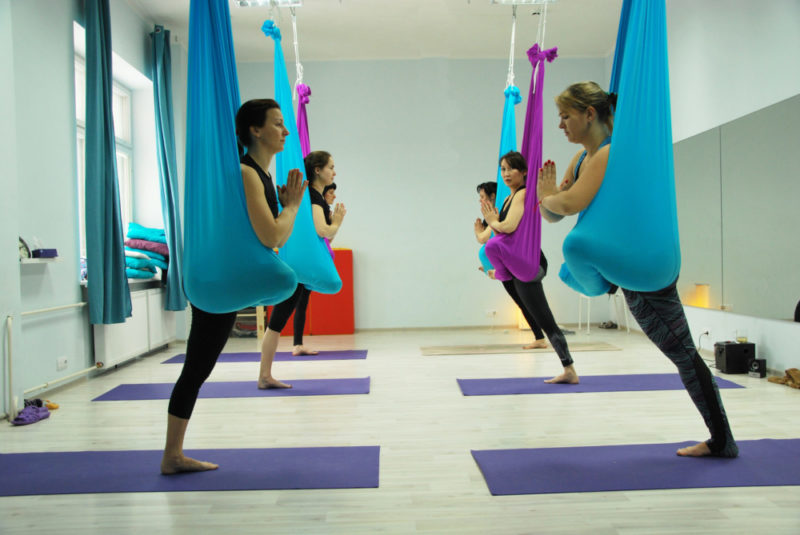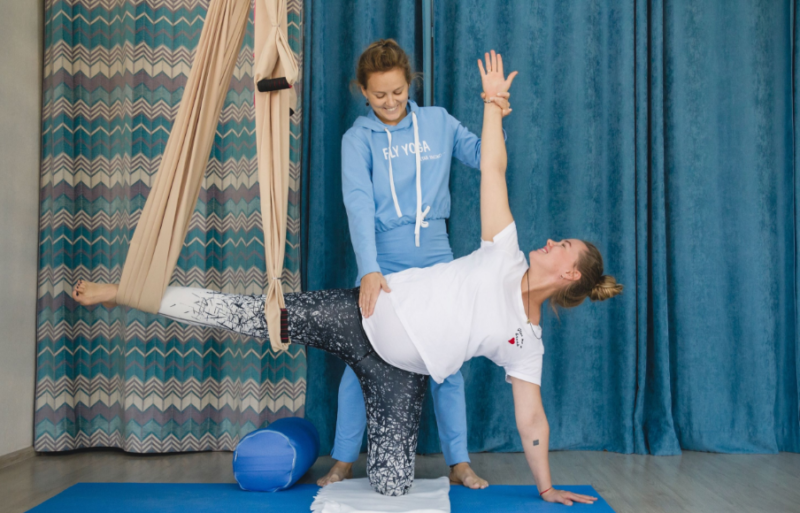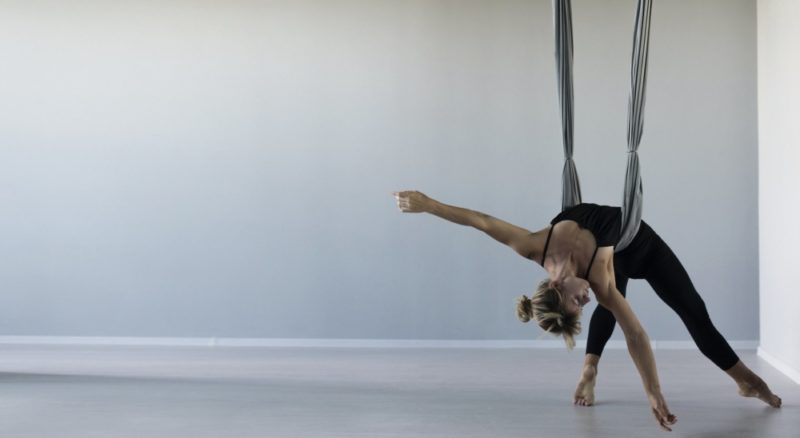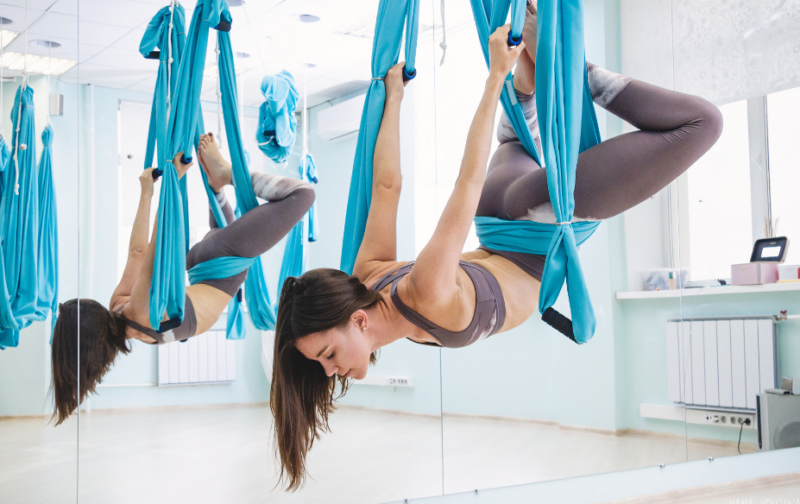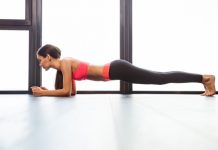Yoga is considered the best choice for people who want to put their body and mind in order. If classical hatha yoga seems too boring, you can pay attention to a new direction - anti-gravity. This is the name of yoga in hammocks, which is rapidly gaining popularity.
Material Content:
What is aerogame
The new direction of fitness has several names at once - aeroyoga, anti-gravity, fly yoga. Its feature is the place where the exercises are performed - about half a meter above the ground, being in a special hammock.
It is difficult to compare yoga in hammocks with classical bodily-spiritual practice, as it is oriented, first of all, to Westerners.
Training consists of elements of hatha yoga, Pilates, stretching and calanetics. This allows you to effectively work out all the muscles during exercise.
Using special nylon hammocks will help trick physics and gravity. As a result, all exercises are performed easier than on the floor, because a significant part of its own weight is held by a special device. This makes fly yoga accessible to any person, regardless of the level of physical fitness.
Benefit and harm for children and adults
The benefits of yoga in hammocks are simplicity and accessibility. It has fewer contraindications compared to other areas of fitness. Both adults and children can attend classes, and everyone will get the result that he personally needs.
The positive side of training is "in the air":
- effective delicate stretching of all muscles;
- stimulation of blood circulation of tissues and organs;
- improved coordination of movements;
- study of all the muscles of the body;
- shaping a slim figure;
- metabolic stimulation;
- improving brain function.
Classes are very useful for the musculoskeletal system. Hammocks reduce the load on the spine and joints, allowing you to effectively form a muscle corset for people with back diseases.
In addition, due to a decrease in the pressure of its own weight on the spinal column, during training, the pain syndrome caused by diseases of the joints and vertebrae decreases.
Another important plus is a positive effect on the nervous system. All the advantages of classical yoga are preserved here - deep relaxation and reduction of the destructive effect of stress.
Yoga in the air will benefit children, especially hyperactive babies. It will be a great way to get rid of excess energy, while improving cognitive abilities (memory, attention) by stimulating cerebral circulation. In addition, such classes are recommended for children with scoliosis and kyphosis, as they help to strengthen the back muscles without excessive stress on the spinal column.
Yoga in the air will help children with cerebral palsy to improve coordination of movements and get rid of muscle clamps.
The harm of exercise is a change in blood pressure. Air exercises in some people can cause headaches and dizziness. This is due to contraindications that must be studied before signing up for the first workout.
Preparing for the first workout
Doing "air" yoga is necessary either on an empty stomach, or two hours after a light breakfast. The best time for training is in the early morning. This is due to the fact that by the evening the body swells due to the amount of fluid drunk during the day, so discomfort during exercise can appear.
In the lesson, you will have to perform inverted asanas, and a full stomach can cause nausea and vomiting.
It is important to choose comfortable clothing. It is best to choose a special jumpsuit made of natural material that stretches well, but is not going to fold. Sports leggings and a comfortable T-shirt are also suitable. Shoes are not needed, the training takes place barefoot, or in open socks.
Types of Aerial Exercises
The exact training program depends on the instructor. Fly yoga leaves everyone with room for imagination, so the fitness centers often change the exercises in each lesson.
In general, regardless of the instructor, any training consists of 6 stages and looks as follows:
- breathing practice;
- warm-up for warming up muscles and joints;
- asanas in a hammock with support on the floor;
- asanas above the floor;
- inverted asanas;
- meditation.
Training begins with breathing exercises that help bring the mind to rest. This is followed by a simple warm-up, usually this stage takes no more than 5 - 10 minutes. After, proceed to the implementation of exercises (asanas) with a gradual complication of poses. At the end is meditation and ten-minute relaxation in the dead man's pose.
The duration of one workout is 90 minutes.
Depending on the qualifications of the trainer, the main focus of the workout is on stretching or strength training. Both types of training in their own way are good for health, therefore it is recommended to clarify the type of exercises with the instructor.
What is useful for pregnant women?
Fly yoga exercises are useful for almost all people. Some facilities offer maternity classes. Poses in hammocks help normalize the general blood flow, get rid of stress and improve lymph outflow, which effectively eliminates edema. In addition, while in the hammock, the load on the lumbar region and the hip area decreases, which positively affects the general well-being.
Despite the undoubted benefit, it is impossible to engage in late pregnancy.At the beginning of gestation, you also need to abandon the load, so yoga for pregnant women can be practiced only in the second trimester, if there are no contraindications. Getting to classes is necessary only after consulting a doctor.
How to choose a hammock for training
Hammock for aerogy is a large section of nylon or cotton fabric of high strength. Hammocks are equipped with special loops and ropes for fixing legs and arms. The fabric can withstand up to 150 - 180 kg, depending on the manufacturer. Each hammock has its own fastening system, allowing you to securely fix it on the ceiling.
When choosing a hammock, you must pay attention to the following product characteristics:
- seam strength;
- fabric quality;
- maximum weight;
- quality of fasteners;
- equipment;
- the presence of loops;
Particular attention must be paid to the seams. Poor quality stitches cannot guarantee safety during class.
The choice of fabric is everyone's personal business. Cotton hammocks are more environmentally friendly, but get dirty faster; nylon hammocks are highly reliable and unpretentious in care.
Contraindications
Like any other area of fitness and yoga, anti-gravity has a number of contraindications. They can be divided into absolute and relative.
Among the absolute contraindications:
- heart failure;
- arterial hypertension;
- epilepsy;
- thrombophlebitis;
- disc herniation;
- protrusion of the vertebrae;
- recent brain stroke;
- malignant neoplasms;
- phlebeurysm;
- high myopia;
- glaucoma.
People with great myopia should be very careful, because inverted asanas cause an increase in intraocular pressure, which is dangerous for the retina. Because of this feature, training is contraindicated in glaucoma.
Relative contraindications include:
- general malaise;
- high temperature
- infectious diseases;
- head injuries;
- exacerbation of gastrointestinal diseases.
In these cases, you just need to wait for the full recovery and recovery of the body, and you can safely proceed to training.
Women during menstruation are not forbidden to do “air” yoga, but it is better to do without inverted asanas.
If you feel unwell during the session, you need to reduce the load or immediately go to meditation and relaxation.
Antigravity will be a great solution for everyone who is tired of standard group fitness training. Classes are simple and exciting, and positively affect the whole body as a whole. The only drawback is not a large number of clubs offering such training. However, beginners are still advised to learn “air” yoga with an instructor, and then you can safely buy a hammock for independent studies and exercise at home.


